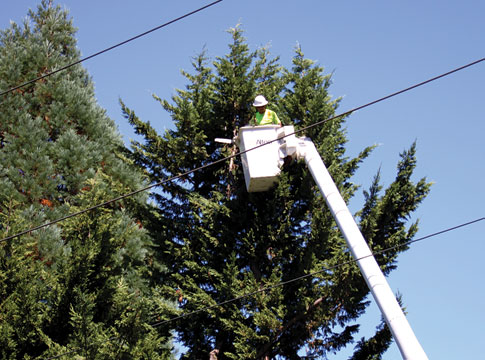Related News
Related News
-
Sustainability Snapshot - Celebrating Energy Efficiency Projects in the Community
Sustainability Snapshops highlight impactful projects completed by EWEB's Customer Solutions department, as a way to celebrate the meaningful work happening behind the scenes.
Find Out More -
Let's Talk Turkey. Is your family ready for winter?
We're heading into the holidays, but that also means snow, ice, and not-so-nice weather might be in the forecast. Here are some tips to prepare in advance.
Find Out More -
The Bonneville Power Administration Rate Change and Your EWEB Bill
BPA’s finalized rate increase is smaller than projected, and EWEB’s pass-through adjustment effective October 1, 2025 will now be 2.7% for residential customers—down from the anticipated 4%.
Find Out More -
Join the Pledge to Prepare
When you think about getting ready for an emergency, you probably have questions. You aren't alone. Preparing for emergencies can be overwhelming, which is why EWEB has put together a 12-month program to help you and your family get two weeks ready.
Find Out More -
You can’t predict the next disaster, but you can prepare
The earthquake lasted less than a minute. But now the power’s out. The tap runs dry. Cell service is spotty. Would you be ready?
Find Out More -
Sustainability Snapshot - Ideal Steel July 2025
Our second Sustainability Snapshop highlights a project where EWEB helped a local industrial warehouse upgrade over 1,000 flourescent lights to new efficient LEDs.
Find Out More -
EWEB Pilots New Line Safety Program for 4th graders.
This year, EWEB is ramping up power line safety for children, specifically 4th graders.
Find Out More -
EWEB opens applications for 2025 Electric Mobility Community Grant
The Eugene Water & Electric Board is now accepting applications for the 2025 Electric Mobility Grant, reinforcing EWEB's commitment to sustainability and cleaner transportation.
Find Out More -
Watch the Recording: Financial Preparedness for Disasters
How will you financially recover after a disaster? This seminar gives key insights into preparing your finances ahead of time.
Find Out More -
Greenpower subscribers vote to award Greenpower Grant to SquareOne Villages
The Greenpower Grant, funded solely by voluntary customer subscriptions, supports local sustainability projects.
Find Out More -
Vote now for the winner of the 2025 Greenpower Grant
Get ready to cast your vote for the winner of the 2025 Greenpower Grant. EWEB is excited to announce the eligible candidates for this year's grant award! The winner of the Greenpower Grant will be voted on by Greenpower subscribers. Learn more about each origanization and their proposal before casting your vote.
Find Out More -
Energy conservation could offset large portion of growth in power demand
Preliminary results of an EWEB study indicate that cutting back demand can contribute to maintaining a reliable, affordable energy supply.
Find Out More -
Small number of McKenzie Valley EWEB customers face higher February bills due to estimated reads
EWEB under-estimated energy usage for about one-fifth of upriver customers in December or January, resulting in higher true-up bills in February.
Find Out More -
EWEB offers Greenpower Grant to support local sustainability project
The Greenpower Grant, funded by voluntary customer subscriptions to Greenpower, not customer grants, supports projects that advance renewable energy, clean energy education or efforts to reduce or offset local carbon emissions.
Find Out More -
EWEB and BRING cook up new ways to help Eugene businesses save energy
Businesses can cut energy costs with EWEB’s free Energy Assessments and efficiency programs. Plus, for a limited time, BRING is offering $1,000 rebates for qualifying upgrades—apply by Feb. 28!
Find Out More - Show More
Tree Pruning Tips
May 12, 2017

Spring is a time of growth and rebirth, especially trees that endured a harsh and icy winter. As you begin thinking about planting new trees around your property, our vegetation management team encourages you to plant the right tree in the right place.
Please consider the tree's height and crown spread - which is the distance the branches will spread away from the trunk - when the tree is fully mature, before planting. If you are considering planting under or next to overhead power lines, we ask that you plant trees that have a mature height of up to 25 feet. Check out a list of power line-friendly trees.
There is nothing like the ice storm that struck Eugene in mid-December to remind us how important it is to prune trees near power lines. Pruning trees is important for customer safety and the reliable delivery of electricity to your home or business. Regular pruning is also important for the health of your trees.
"We operate on a four-year cycle where we inspect our power lines and the trees near them, and we then prune with the hope of getting the trees and vegetation to hold four years," said Julie Nuttall, EWEB's vegetation management supervisor.
If there are any fast-growing trees or vegetation that will not hold for the entire four-year cycle, we will revisit the "hot spot" two years after the original inspection. The pruning clearances are based on tree species, growth rate and the location of the tree.
We follow the American National Standards Institute A300 pruning standards, known as "directional pruning," which directs the growth away from power lines. Julie's team of three foresters and 11 contract crews pruned approximately 300 line miles worth of trees in 2016.
Trees in the vicinity of overhead utility lines could be potentially hazardous, but pruning them by yourself is also dangerous. If you contact our vegetation management department at (541) 685-7000, a forester will come out and evaluate your trees.
"If we determine the tree to be a good candidate for removal, we will work out the details with the customer and have a voucher we can offer to replace it with a power line-friendly tree," Julie said.

